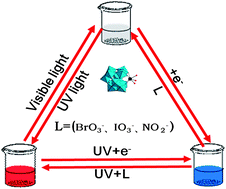
Detection of nitrite, iodate and bromate with Eu-POM sensor
Nitrite, iodate and bromate are commonly found in food and drinking water and they can play important roles in human health. Iodine compounds, for example, are crucial to the smooth running of the thyroid, while bromate is a by-product of water purification. However, the consumption of excessive amounts of these ions can cause serious health issues. Current methods of detecting nitrite, iodate and bromate largely rely on expensive spectroscopic equipment and time consuming chemical analysis.
Li-Hua Bi and Li-Xin Wu from Jilin University, China, have developed a novel detection method which utilises the electrochemistry and redox properties of a europium polyoxometalate (Eu-POM) sensor. The Eu-POM is electrochemically reduced, leading to luminescence quenching and a change in the solution from colourless to blue. The presence of oxidising nitrite, iodate and bromate ions reverses this process, affording discolouration and luminescence recovery. The colour change can be recycled infinitely, and measured using a UV-vis spectrometer. This sensor demonstrates a good linearity relationship between absorbance and concentration of NO2–, IO3– and BrO3–.
The simplicity of this method, along with high sensitivity and low detection limits, make it an attractive prospect for future use in the sensing of these ions in solution.
A novel detection of nitrite, iodate and bromate based on a luminescent polyoxometalate
Bin Wang, Rui-Qi Meng, Ling-Xiao Xu, Li-Xin Wu and Li-Hua Bi
Anal. Methods, 2013, Advance Article
DOI: 10.1039/C2AY26217G










